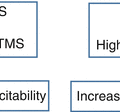Systems
Physiological changes in the elderly after surgery/immobility and under rehabilitation
Clinical changes
Cardiovascular system
↓ Heart rate reached
↓ Heart’s contractility
↑ Cardiac workload
↑ Blood pressure
– Orthostatic intolerance
– Hypertensive crises
– Tachycardia
Respiratory system
↓ Residual functional capacity
↑ Flow resistance
↓ VO2 max
↓ Maximum aerobic capacity
– ↓ Fatigue threshold
Skeletal muscle
↓ Peripheral artery vasodilation
↓ Oxygen extraction capacity
↓ Muscle work
↓ Aerobic threshold
↑ Lactate production
– Early fatigue
– Muscle cramps/pain
– Disclosing tendinitis, arthritis, arthrosis, bunions, or radiculitis
Metabolism
Low-intensity prolonged exercising/moderately intense exercise (50–60% VO2 max) → metabolism of blood glucose and muscular and hepatic glycogen
↓
↑ Consumption of glucose
↑ Muscle insulin sensitivity
– ↑ Risk of hypoglycemia
Water/electrolyte balance
↑ Body temperature
↑ Perspiration
↑ Electrolyte loss
– ↑ Dehydration
– ↑ Hyponatremia/hypokalemia
Physiologically, the cardiovascular system responds to exercise by increasing cardiac output, speeding up heart rate and left ventricular outflow, and simultaneously raising blood pressure and redistributing the blood volume in favor of the muscles involved in the physical activity underway.
During exercise, heart rate is usually lower in older people (220 minus the patient’s age), while blood pressure is higher, with a consequent greater cardiac workload. Moreover, heart’s contractility and peripheral artery vasodilation decline with aging [6].
Surgery and long periods of immobility determine many modifications in the cardiovascular system. For instance, orthostatic intolerance (due to recent sedation or baroreceptor-depressed sensitivity) is common. Hypovolemia (due to a loss of fluids or a reduced liquid intake) causes hypotension and tachycardia. The residual effects of sedation depress baroreceptor sensitivity, giving rise to hypotension and bradycardia. Inadequate pain control prompts tachycardia and hypertension.
In the early period of a rehabilitation program, a patient may consequently have many medical conditions. Orthostatic hypotension is frequent and identified in 50% of patients undergoing PTA, for instance [7], while hypertensive crises may occur during the rehabilitation treatment.
Although the age-related deterioration in the respiratory system is not considered a factor restricting exercise capacity, and the oxygen pressure is maintained up to maximal exercise capacity [6], an elderly patient who has just had surgery under general anesthesia or been bedridden for some time will have a lower residual functional capacity and a higher flow resistance. This means that the patient’s VO2 max [6]—maximum oxygen consumption—and therefore his/her maximum aerobic capacity will be reduced and may consequently be unable to cope with the greater oxygen demand of the muscles being exercised, and this means the muscles will have a lower fatigue threshold.
When solicited by exercise, muscles divert the blood flow toward them by dilating the blood vessels (during strenuous exercise, the blood flow toward the muscles reaches 80% of the total) and increasing its oxygen extraction capacity. In the elderly, these mechanisms are less effective, as shown by the a-vO2 difference values. In addition, older people produce less muscle work for the same amount of energy resources than younger people, and this lowers the former’s aerobic threshold.
For all these reasons, the lactate production threshold drops, and individuals with an impaired clearance are likely to suffer from muscle cramps, which will limit their physical activity, and the effort needed for the body to offset acidosis may increase pulmonary workload.
Complications affecting the skeletal muscle during exercise recovery are usually mild and often associated with an inadequate warm-up or over-strenuous therapeutic programs [8]. Exercise may also disclose previously existing conditions such as tendinitis, arthritis, bunions, and radiculitis or give rise to new conditions such as muscle strain.
Pain is one of the most important players that can appear during rehabilitation exercise. Its perception depends on the patient’s pain threshold and may result in stopping the treatment. It can be caused by the abovementioned lactic acidosis, by an acute exacerbation of already known osteoarticular disorders, and by movements of the limb involved in the previous surgical procedure (in orthopedic patients) or affected by muscle fibrosis and tendon retraction (in cases of paresis or plegic patients) and by paresthesias or dysesthesias along root nerves damaged by orthopedic or neurological conditions (e.g., phantom limb pain in amputees).
Stay updated, free articles. Join our Telegram channel

Full access? Get Clinical Tree




